Who are these scientists who are boarding the Ifremer oceanographic vessel from Sète ?
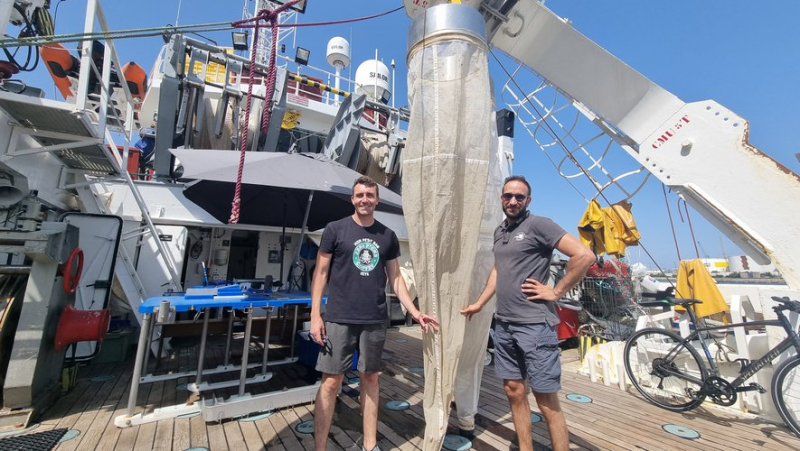
Jean-Hervé Bourdeix, head of mission and Tarek Hattab, scientific manager of the Pel Med campaign. Hélène Amiraux
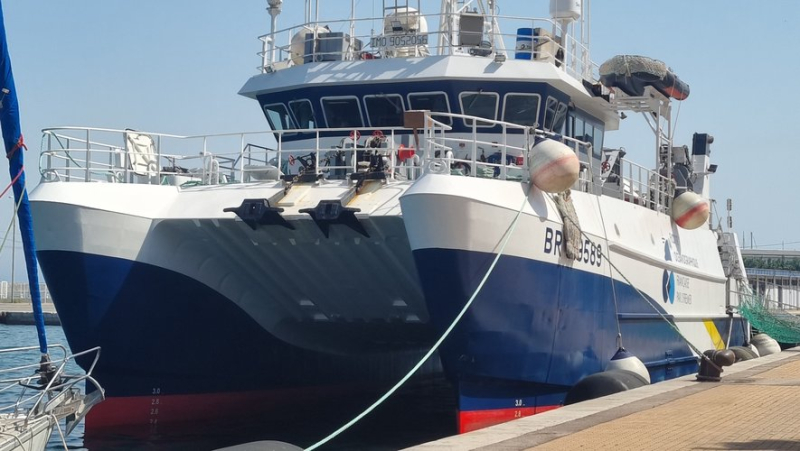
Europe, a ship armed for scientific fishing. Hélène Amiraux
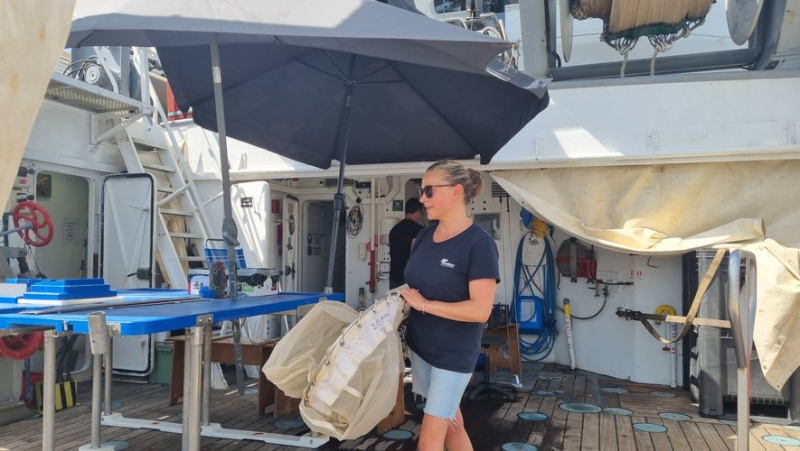
The team of scientists from the Pel Med campaign returns to port after a month of mission. Hélène Amiraux
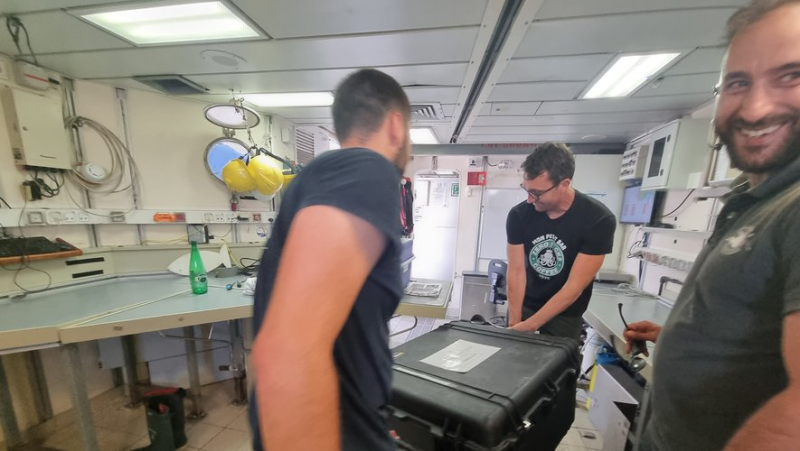
The measuring instruments of the on-board laboratory are carefully packed to join the Ifremer station. Hélène Amiraux

In the saloon, the atmosphere is friendly between scientists and sailors on board. Hélène Amirals

Observers from the Pelagis group count mammals and birds during the mission. Hélène Amiraux
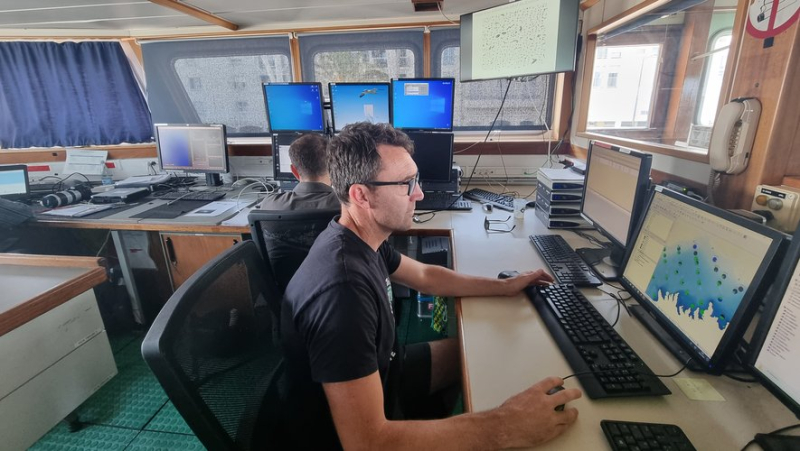
Dans le PC science, les responsables de la mission scrutent les écrans des échosondeurs. Hélène Amiraux
A bord de l’Europe, le navire scientifique de l'Ifremer de Sète, ces chercheurs sillonnent la Méditerranée pour évaluer les stocks de poissons. Midi Libre est monté à bord.
The Europe is a somewhat special ship. While it is equipped for fishing, its trawls are used for oceanographic research. Moored at the Algiers quay in mid-July, its crew was returning from an exploratory mission. In a well-oiled ballet of storage boxes, measuring instruments and samples stored in the on-board laboratory are carefully unloaded, heading for Ifremer in Sète. After taking turns on board for about thirty days, the six scientists must vacate their cramped bunks and say goodbye until next year.
40 miles from the coast
Since 1993, the Ifremer scientific fleet boat, chartered by its subsidiary Genavir, has embarked teams of researchers responsible for carrying out study campaigns on fish stocks (Pel Med and Medits) in the Mediterranean. . Valuable work intended to regulate the management of fish populations, within the framework of international protocols.
Tarek Hattab, head of the Pel Med program, is responsible for assessing anchovy and sardine populations, through acoustic prospecting at sea supplemented by fish trawling. With Jean-Hervé Bourdeix, head of mission, operational manager on board the Europe, and a multidisciplinary team, they have just crisscrossed the Gulf of Lion to Marseille and Cassis, 40 miles from the coast, for a month (with a return to land every five days).
Medits, Pel Med two scientific campaigns departing from Sète
Every summer, the boat the Europe embarks two teams from Ifremer in Sète, each tasked with carrying out two campaigns to assess specific resources. The first, Medits (MediIterranean Trawl Survey), in the spring, led by Grégoire Certain (Ifremer Sète), whose objective is the assessment of demersal stocks (hake, red mullet, monkfish, crustaceans and cephalopods) by bottom trawling in the Gulf of Lion and eastern Corsica (other countries are participating in this vast study: Spain, Italy, France, Greece, Cyprus, Malta, Slovenia, Croatia, Montenegro and Albania).
The data from the campaign are used to provide several indicators required by fisheries managers, for international expertise purposes (stock assessment of the General Fisheries Commission for the Mediterranean (GFCM) and the Scientific, Technical and Economic Committee for Fisheries (STECF)). In summer, the Pel Med (Pelagic Mediterranean) mission, dedicated to the study of anchovy and sardine populations, takes over.
During the latter, scientists from the Pelagis Observatory (joint unit of the CNRS and La Rochelle University in partnership with the Ministry in charge of Ecology) participated in the program. Its members note the presence of mammals and birds, but also pollution and human activities. Scientists from the Gulf of Lion marine park (between Leucate and Cerbère) were also part of the adventure.
"A change has been observed in zooplankton with their size decreasing"
At “PC Science”, at the footbridge, the day starts at sunrise, around 6:30 a.m. "Let's launch echo sounders to quantify species, based on a sampling plan along fixed trajectories called radials. We have nine, they are the same since 1993", explains Tarek Hattab, based at Ifremer in Sète. When a signal appears on the screen, measurements begin. "We start fishing at 8 knots to check the echogram data", says Jean-Hervé Bourdeix. The maturity stage, sex, and age of the species are recorded. Water and plankton samples are then necessary: “We set up a biological station, i.e. measurements of physicochemical parameters that then make it possible to note any possible climate change. We have noted a warming since 1993”, the two experts specify. The content of the plankton samples is passed to the zoocam (a huge camera that works with AI): “We can thus have results in real time on the boat. Before, we had to wait several months, Tarek Hattab rejoices. We have observed a change in the zooplankton, which is reducing in size. Fish need more energy to filter it and therefore to feed themselves. "
“A vision of the entire ecosystem”
A trawl lasts 1 hour 30 minutes on average, the team can carry out three per day, with two biological stations. Everything is recorded in the watch log. These precise operations are impossible to implement without the help of the Gevanir crew, often Breton, of the boat (12 members, including a night watch lieutenant). It is the commander Steven Guennec, a former trawl fisherman in Guilvinec, who authorizes the boat to maneuver to reach the school of fish detected. Then, the bosun takes over to direct the trawling. He is the one who acts as the link between the scientists and the sailors on board. In Europe, Madjid Bouayad-Agha occupies this strategic position.“It's a second youth because it's the job I've always dreamed of doing”, confides the man who worked for a long time on fishing boats in Sète. Notably as a fillet mender. He who also fought for the profession and those who make a living from it.
After four years of a long wait, he finally got hired at Genavir “two days before leaving for the North Sea”, remembers the sailor, satisfied to have gone from “exploitation to species conservation, it makes sense”, he says.
On a daily basis, Madjid Bouayad-Agha ensures the safety of the equipment, the men and the organization of work on deck. It contributes to the “family” atmosphere on board, a crucial element of the mission.
The research team also includes a group of mammal and bird observers. “This gives us a view of the entire ecosystem because we cannot manage fish resources independently of their physical and chemical environment, plankton, mammals, and even floating waste or human activities”, explains Tarek Hattab.
“Detection is mainly done by eye, assures Vincent from the Pelagis Observatory. In a second step, we can check with binoculars. Sometimes, we take photos to check the identification of the species when the passage is fleeting". Bottlenose dolphins, fin whales, sperm whales, pilot whales have crossed the road to Europe. More rare, three puffin birds "a little lost in the middle of 95 boats!" A nice souvenir for Vincent's first mission in the Mediterranean.
I subscribe to read the rest




